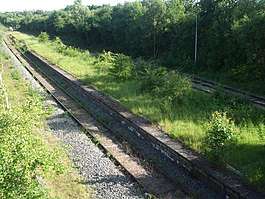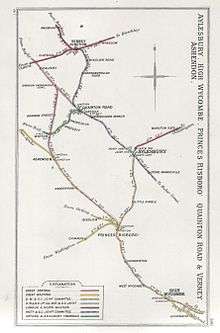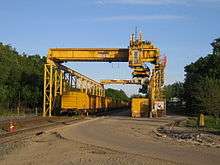Calvert railway station
Calvert was a railway station at Calvert, Buckinghamshire on the former Great Central Main Line between Manchester Piccadilly and London Marylebone. The station was opened in 1899 and closed to passengers in 1963 and goods in 1964. The line through it remains open for freight, including waste to a landfill site.
| Calvert | |
|---|---|
 Site of Calvert Station in 2008 | |
| Location | |
| Place | Calvert |
| Area | Buckinghamshire |
| Grid reference | SP689247 |
| Operations | |
| Original company | Great Central Railway |
| Pre-grouping | Great Central Railway |
| Post-grouping | London and North Eastern Railway London Midland Region of British Railways |
| Platforms | 2 |
| History | |
| 15 March 1899 | Opened |
| 4 March 1963 | Closed to passengers[1] |
| 4 May 1964 | Closed to goods |
| Disused railway stations in the United Kingdom | |
| Closed railway stations in Britain A B C D–F G H–J K–L M–O P–R S T–V W–Z | |
History
Calvert was the last station on the Great Central's London Extension before it reached the Metropolitan's station at Quainton Road 4.5 miles (7.2 km) away. The station and line between Brackley and Quainton Junction were constructed by Walter Scott and Company of Newcastle upon Tyne. Although the station was named Calvert, no such place existed at the time and the name was that of the local landowner, Sir Harry Verney, who had been born a Calvert but changed his name upon succeeding to the Verney Baronetcy.[2]
At the time, Calvert was a very rural settlement with the few houses making up the village being situated close to the station and nearby brickworks which was the largest employer in the area. In true Great Central style, the station had a single island platform located below a road overbridge from the centre of which a staircase led down to the platform; the centre piers of the bridge were left hollow to provide lamp rooms. The design was chosen as it would allow the track to be quadrupled if ever required.[3] About 2.5 miles (4.0 km) south of Calvert was Grendon Underwood Junction where "Calvert Cabin" signal box controlled the line as it split into two: one line branching out towards Princes Risborough, the other towards Amersham.[4]
A connecting spur, brought into use on 14 September 1940, linked Calvert with the Oxford to Bletchley line with the Great Central, allowing much of the freight which used the Verney Junction - Quainton Road section to be diverted over the Great Central.[5] Calvert was to remain open a further 23 years before closing to passengers on 4 March 1963, the same day as nearby Quainton Road. Fast passenger trains continued to pass through the station until 1966 when the Great Central Main Line was closed.
Routes

| Preceding station | Disused railways | Following station | ||
|---|---|---|---|---|
| Quainton Road Line and station closed |
Great Central Railway London Extension |
Finmere Line and station closed | ||
| Akeman Street Line and station closed |
Present and future
The station platform remains in a dilapidated state, although the station buildings have long since been demolished. The stationmaster's house stands nearby.

A single track of the former Great Central alignment through Quainton Road to Calvert remains open as far as the disused Varsity Line for occasional freight and DMU maintenance workings. The line is being kept open as it also serves the waste transfer station at Calvert Landfill Site operated by FCC Environment for the Department of the Environment. Five container trains each day use the site: four from Brentford (known as the "Calvert Binliner", and one from Bath and Bristol (known as the "Avon Binliner"). The containers, each of which contains 14 tons of waste, are unloaded at the transfer station onto lorries awaiting alongside which then transport the waste to the landfill site.[6] The site, dating from 1977 and now one of the largest in the country, stretches to 314 hectares and partly reuses the clay pits dug out by Calvert Brickworks which closed in the 1980s.[7][8] The line is expected to become part of East West Rail however there are no plans to reopen Calvert railway station.
The railway line through Calvert adjacent to the planned High Speed 2 Rail Link Phase One, announced on 11 March 2010 by Lord Adonis on behalf of the DfT. The line will pass through the site of the disused station.[9] This location (called 'Thame Road') and a fall-back site, 'Great Pond' were announced in December 2010 as the site for the HS2 maintenance depot.[10] The nearby Calvert Waste Plant has also been identified for heat and power generation.[10]
External links
References
- Butt, R.V.J. (1995). The Directory of Railway Stations, Patrick Stephens Ltd, Sparkford, ISBN 1-85260-508-1, p. 51.
- Dow, George (1962). Great Central: Volume 2 Dominion of Watkin 1864-1899. Shepperton, Surrey: Ian Allan Limited. pp. 322–323.
- Davies, R.; Grant, M.D. (1984). Forgotten Railways: Chilterns and Cotswolds. Newton Abbot, Devon: David St John Thomas. pp. 193–194. ISBN 0-946537-07-0.
- Healy, John M.C. (1987). Great Central Memories. London: Baton Transport. pp. 118–119. ISBN 978-0-85936-193-4.
- Davies, R and Grant M.D., op. cit. p. 89.
- "Waste transfer station, Calvert Landfill... (C) Andy Gryce". www.geograph.org.uk.
- "Calvert Landfill Site (C) Andy Gryce". www.geograph.org.uk.
- "Calvert Landfill Site history and operations". fccenvironment.co.uk. Retrieved 5 February 2018.
- "HS2 Phase One: updated plan and profile maps for Country South 2016" (PDF). www.gov.uk. DfT. Retrieved 5 February 2018.
- Infrastructure Maintenance Depot Archived 31 January 2011 at the UK Government Web Archive Released December 2010